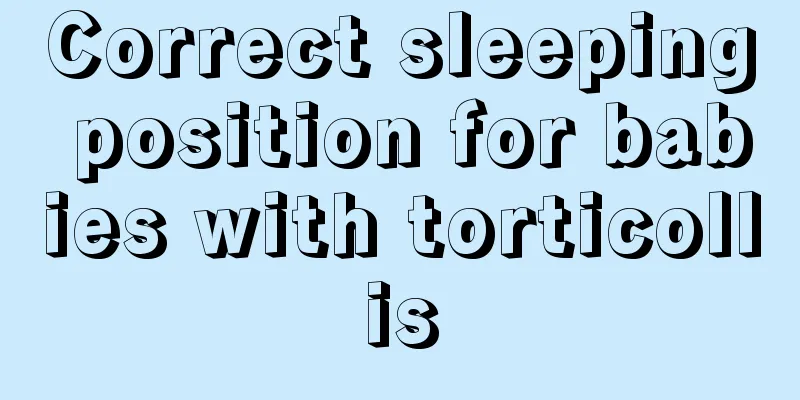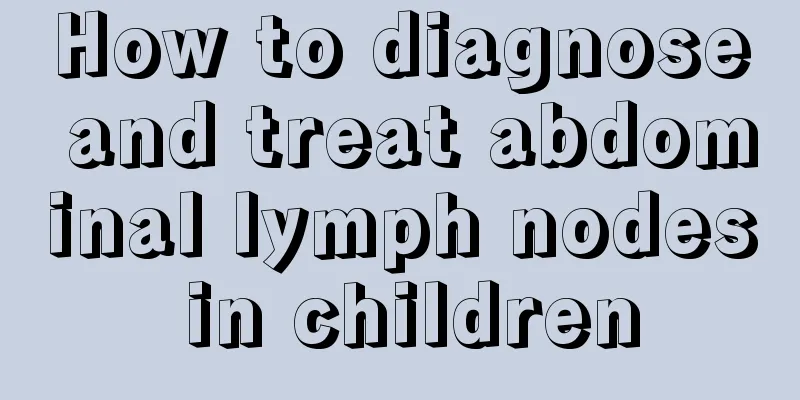Correct sleeping position for babies with torticollis

|
If your baby already has torticollis, you should pay attention to his or her sleeping position. If the sleeping position is not good, the torticollis will become more serious. Even when holding your baby, you cannot always hold the baby in the same position. You have to switch left and right. Only by frequently changing your baby's sleeping direction can you avoid the torticollis from becoming more serious. After treatment, you should also prevent your baby from eating too greasy food. When the baby is young, you should alternate between holding and feeding him with your left and right hands, and change his sleeping direction to avoid the formation of habitual torticollis.Dietary precautions Disease taboos Do not eat too much greasy food after surgery Diet Encourage children to eat more after surgery to ensure nutritional intake, which is beneficial to wound healing.
Care methods Within 6 hours after surgery, the head should be tilted to one side to prevent aspiration. Within 2 days after surgery, reduce moving, distract attention, reduce pain, change dressings frequently, and avoid wound contamination. Starting from the second day after surgery, give cervical traction during the day and maintain it for one week. After one week, fix the neck with a cervical brace for 3 to 6 months. Rehabilitation training began on the second day after the operation, pulling the neck toward the healthy side and fully stretching the sternocleidomastoid muscle to avoid recurrence of adhesions. This training was maintained for half a year. Precautions After the operation, pay close attention to wound bleeding, breathing, and the presence of pneumothorax. B-ultrasound examination compares the thickness and texture of the sternocleidomastoid muscles on both sides, which helps to distinguish whether it is muscular torticollis.
1. Bony torticollis: Cervical abnormalities such as atlantoaxial subluxation, hemivertebra, etc. can be confirmed by further X-ray examination, and the sternocleidomastoid muscle is not contracted. 2. Neck inflammation: There is lymphadenopathy, tenderness and systemic symptoms, but no contracture of the sternocleidomastoid muscle. 3. Eye muscle abnormalities: There is an imbalance in the strength of the extraocular muscles, and strabismus requires a tilt of the neck to coordinate vision. It is recommended to see an ophthalmologist to rule it out. The pathogenesis is still unclear, the main one is the intrauterine compression theory: it is caused by pressure changes caused by malposition of the fetus in the uterus. Blood supply obstruction theory: Occlusion of the arteries and veins supplying the sternocleidomastoid muscle causes muscle fibrosis. Genetic theory: About 1/5 of the children have a family history and are accompanied by other deformities. Birth injury theory: Torticollis often occurs in cases of difficult labor and delivery, especially breech presentation, which accounts for about 3/4. |
<<: How to correct left-side torticollis in babies
>>: The child's head tilts to one side, which is torticollis
Recommend
Tips for children to kick off the quilt when sleeping
Taking care of a baby is the most tiring thing. A...
Why does the baby cry when defecating?
Generally speaking, when taking care of babies in...
What is the situation of baby's lips not rosy
We all know that rosy lips are a sign of good hea...
Why do four-year-old children become sleepy?
Children need more sleep than adults, and if thei...
Reasons for high lymphocyte percentage in infants
Babies have just come into the world and have not...
What to do if baby has high jaundice
Every parent hopes that their baby can come into ...
What should I do if my child catches a cold and urinates frequently?
Compared with adults, children have relatively po...
Why do young children with acute gastroenteritis only vomit but not have diarrhea?
For children, because their stomachs and intestin...
What should I do if my child always has a sore throat?
Due to reasons such as getting angry, viral infec...
What should I do if my child has diarrhea in the middle of the night?
As we all know, the gastrointestinal function of ...
Symptoms of developmental delay in children
Developmental delay in children is a problem that...
What to do if your child has bloating or stomach pain
Nowadays, many babies are sent to kindergartens b...
What are the reasons for baby's black lips?
Whether the baby can grow up healthily concerns t...
What kind of fruit is good for a three-year-old child?
Fruits are not only delicious but also have high ...
Medicine for jaundice in newborns
For mothers, the happiest and most painful moment...









